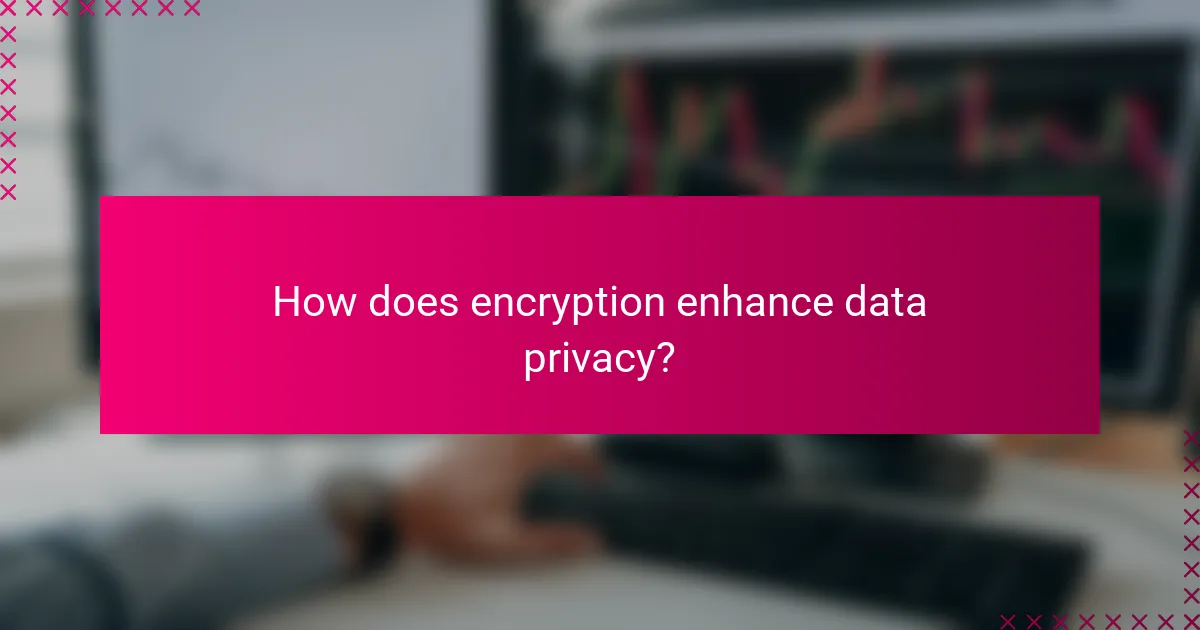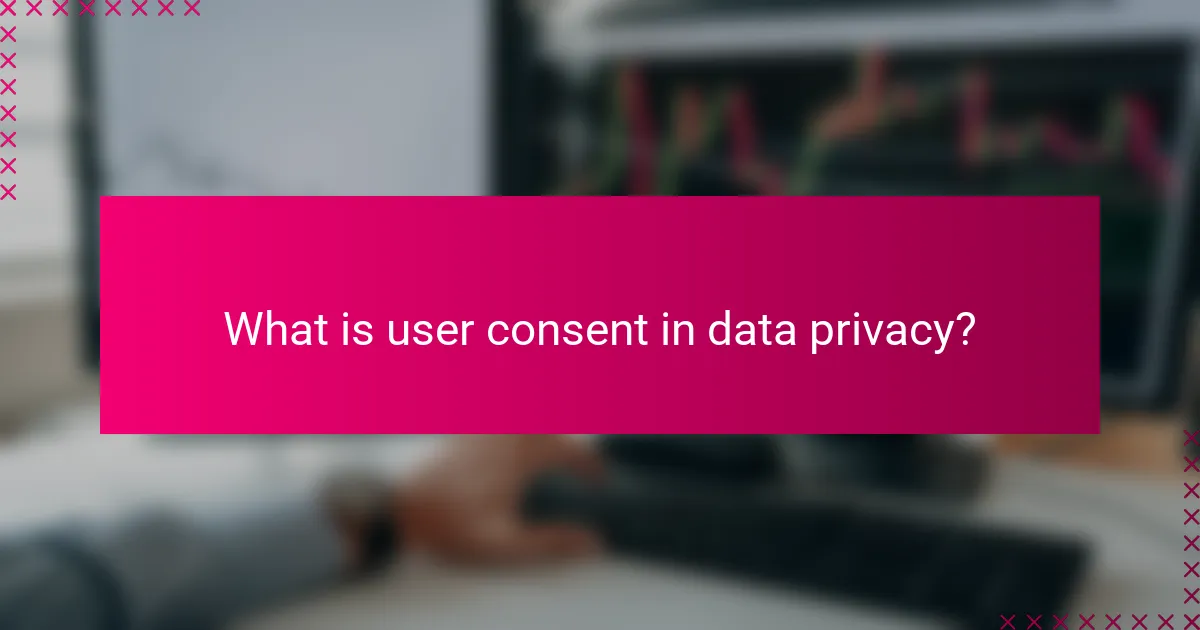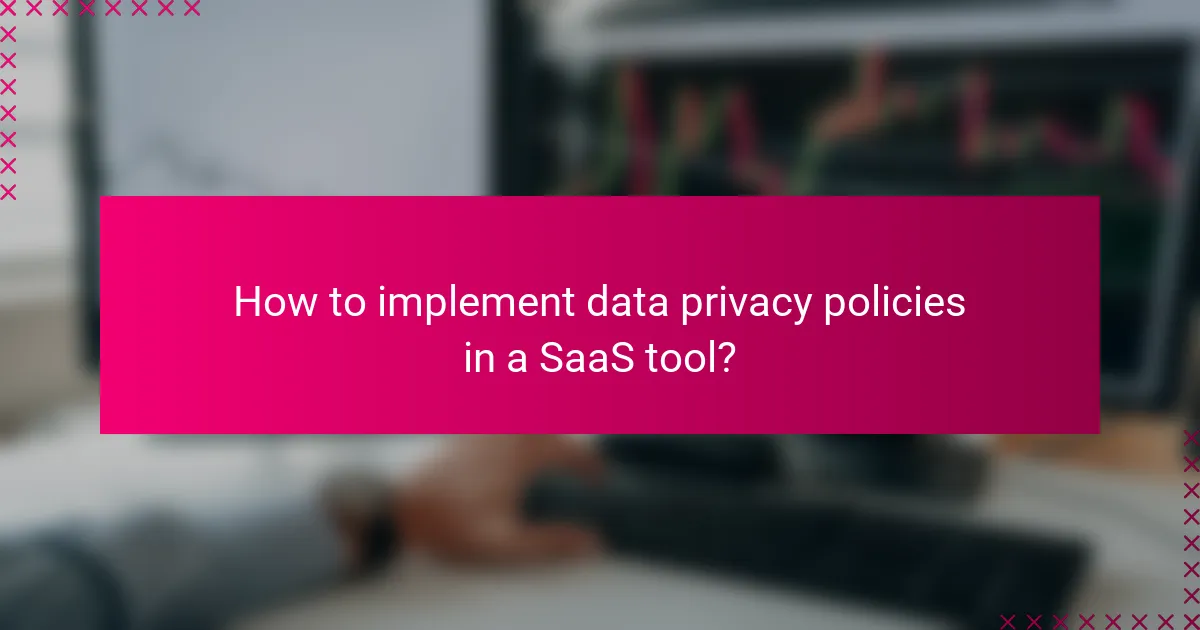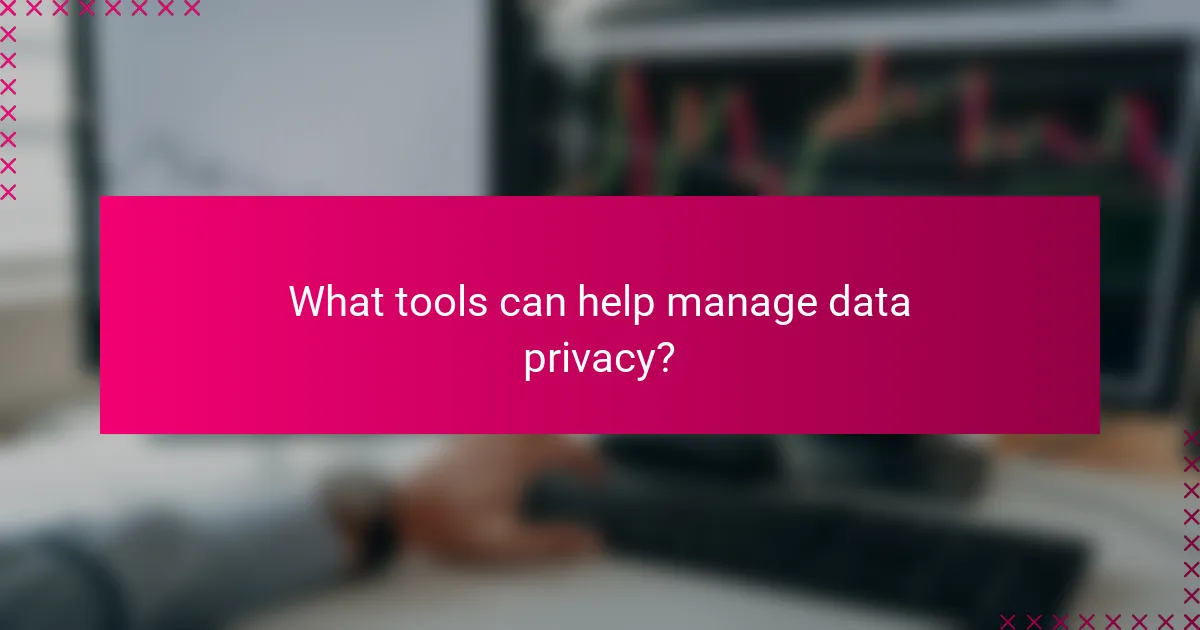Data privacy is a critical concern in today’s digital landscape, shaped by regulations like the General Data Protection Regulation (GDPR) in the UK. These policies empower individuals to control their personal information while ensuring organizations manage data responsibly. Encryption plays a vital role in safeguarding sensitive data by encoding it, thus preventing unauthorized access. Additionally, user consent is essential, as it grants individuals the authority over their data and clarifies its intended use.

What are the key data privacy policies in the UK?
The UK has established several key data privacy policies to protect personal information, primarily influenced by the General Data Protection Regulation (GDPR). These regulations ensure that individuals have control over their data and that organizations handle it responsibly and transparently.
General Data Protection Regulation (GDPR)
The GDPR is a comprehensive data protection law that applies across the UK and the EU. It mandates that organizations must obtain explicit consent from individuals before collecting or processing their personal data.
Key principles of GDPR include data minimization, purpose limitation, and accountability. Organizations must ensure that personal data is collected for legitimate purposes and is not kept longer than necessary.
Failure to comply with GDPR can result in significant fines, often reaching millions of euros or a percentage of the organization’s annual revenue, emphasizing the importance of adherence to these regulations.
Data Protection Act 2018
The Data Protection Act 2018 complements the GDPR in the UK, providing specific provisions for data processing and the rights of individuals. It establishes the Information Commissioner’s Office (ICO) as the regulatory body responsible for enforcing data protection laws.
This Act outlines the rights of individuals, such as the right to access personal data, the right to rectification, and the right to erasure. Organizations must have clear policies in place to uphold these rights and respond to requests from individuals.
Additionally, the Act includes provisions for processing special categories of data, such as health information, which require higher levels of protection and consent.
Privacy and Electronic Communications Regulations (PECR)
The Privacy and Electronic Communications Regulations (PECR) govern the use of electronic communications and marketing in the UK. These regulations require organizations to obtain consent before sending marketing communications via email, SMS, or other electronic means.
PECR also mandates that organizations provide clear information about cookies and similar technologies used on their websites. Users must be informed and give consent before cookies are placed on their devices.
Non-compliance with PECR can lead to enforcement actions by the ICO, including fines and orders to cease unlawful marketing practices, making it essential for businesses to understand and implement these regulations effectively.

How does encryption enhance data privacy?
Encryption enhances data privacy by converting sensitive information into a coded format that can only be accessed by authorized users. This process protects data from unauthorized access, ensuring that personal and confidential information remains secure during transmission and storage.
End-to-end encryption
End-to-end encryption (E2EE) ensures that data is encrypted on the sender’s device and only decrypted on the recipient’s device. This means that even if the data is intercepted during transmission, it remains unreadable to anyone other than the intended recipient. Popular messaging apps like WhatsApp and Signal utilize E2EE to protect user conversations.
For effective E2EE, both parties must use compatible applications that support this encryption method. Users should verify the security settings of their chosen platforms to ensure their communications are fully protected.
Symmetric vs. asymmetric encryption
Symmetric encryption uses a single key for both encryption and decryption, making it faster and suitable for encrypting large amounts of data. However, the challenge lies in securely sharing the key between parties. Common symmetric algorithms include AES (Advanced Encryption Standard).
Asymmetric encryption, on the other hand, employs a pair of keys: a public key for encryption and a private key for decryption. This method is more secure for key exchange but typically slower than symmetric encryption. RSA (Rivest-Shamir-Adleman) is a widely used asymmetric encryption algorithm.
Encryption standards (AES, RSA)
AES is a symmetric encryption standard widely adopted for securing sensitive data, known for its efficiency and strong security. It supports key sizes of 128, 192, and 256 bits, with longer keys providing higher security levels. AES is commonly used in various applications, including file encryption and secure communications.
RSA is a standard for asymmetric encryption that relies on the mathematical difficulty of factoring large numbers. It is often used for secure data transmission and digital signatures. RSA key sizes typically range from 2048 to 4096 bits, with larger keys offering enhanced security but requiring more processing power.

What is user consent in data privacy?
User consent in data privacy refers to the permission granted by individuals for the collection, processing, and sharing of their personal information. It is a fundamental aspect of data protection laws, ensuring that users have control over their data and understand how it will be used.
Explicit vs. implicit consent
Explicit consent requires a clear and affirmative action from the user, such as checking a box or signing a form, indicating their agreement to data processing. This type of consent is often necessary for sensitive data, as outlined in regulations like GDPR.
Implicit consent, on the other hand, can be inferred from a user’s actions or behavior, such as using a service that requires data sharing. While it may simplify the process, relying solely on implicit consent can lead to misunderstandings about user expectations and rights.
Consent management platforms (CMP)
Consent management platforms (CMP) are tools that help organizations collect, manage, and document user consent for data processing. They streamline the consent process by providing users with clear options and ensuring compliance with regulations.
Using a CMP can enhance transparency and trust, as users can easily access their consent preferences and make changes as needed. When selecting a CMP, consider factors such as ease of integration, user experience, and compliance capabilities.
Impact of consent on data processing
User consent significantly impacts how organizations can process personal data. Without proper consent, data processing activities may be deemed illegal, leading to potential fines and reputational damage.
Organizations must regularly review and update their consent practices to align with evolving regulations and user expectations. Implementing clear consent mechanisms and respecting user choices can foster trust and encourage positive engagement with your brand.

How to implement data privacy policies in a SaaS tool?
Implementing data privacy policies in a SaaS tool involves establishing clear guidelines for data collection, usage, and protection. Key steps include ensuring compliance with relevant regulations, utilizing encryption, and creating user consent mechanisms.
Integrating GDPR compliance features
To integrate GDPR compliance features, start by assessing what personal data your SaaS tool collects and how it is processed. Implement user rights such as data access, rectification, and deletion, ensuring users can easily exercise these rights.
Consider incorporating a data protection impact assessment (DPIA) to identify risks and mitigation strategies. Regular audits and updates to your privacy policy will help maintain compliance and build user trust.
Utilizing encryption protocols
Encryption protocols are essential for protecting sensitive data both in transit and at rest. Use industry-standard encryption methods such as AES-256 for data storage and TLS for data transmission to safeguard user information.
Regularly review and update your encryption methods to counter emerging threats. Providing users with clear information about your encryption practices can enhance their confidence in your tool’s security.
Creating user consent workflows
Creating user consent workflows involves designing clear processes for obtaining and managing user consent for data collection and processing. Use simple, straightforward language in consent forms to ensure users understand what they are agreeing to.
Implement mechanisms for users to easily withdraw consent at any time, and keep records of consent to demonstrate compliance with regulations. Regularly review these workflows to adapt to changing legal requirements and user expectations.

What are the best practices for data privacy in SaaS?
Best practices for data privacy in Software as a Service (SaaS) include implementing regular audits, training employees on data protection, and adopting data minimization strategies. These practices help ensure compliance with regulations and protect user information from breaches.
Regular audits and assessments
Conducting regular audits and assessments is crucial for maintaining data privacy in SaaS. These evaluations help identify vulnerabilities, ensure compliance with data protection regulations, and assess the effectiveness of existing security measures.
Organizations should schedule audits at least annually and after significant changes to systems or processes. Utilizing third-party auditors can provide an unbiased perspective and enhance the credibility of the findings.
Employee training on data protection
Training employees on data protection is essential for fostering a culture of privacy within the organization. Staff should be educated on the importance of data privacy, common threats, and best practices for handling sensitive information.
Regular training sessions, ideally every six months, can keep employees informed about evolving threats and compliance requirements. Incorporating real-world scenarios and practical exercises can enhance the effectiveness of the training.
Data minimization strategies
Data minimization strategies involve collecting only the necessary information required for specific purposes. This approach reduces the risk of data breaches and helps organizations comply with regulations like the GDPR.
To implement data minimization, businesses should regularly review the data they collect and retain, ensuring it aligns with their operational needs. Establishing clear data retention policies can further support this strategy by defining how long data should be kept and when it should be securely deleted.

What tools can help manage data privacy?
Effective data privacy management relies on a combination of tools that enhance security, ensure compliance, and facilitate user consent. Key tools include encryption software, privacy management platforms, and consent management solutions.
Encryption Software
Encryption software protects sensitive data by converting it into a secure format that can only be accessed with a decryption key. This is crucial for safeguarding personal information during storage and transmission. Popular encryption tools include VeraCrypt and BitLocker.
When selecting encryption software, consider the type of data you need to protect and the regulatory requirements applicable to your industry. For instance, healthcare organizations often need to comply with HIPAA regulations, which mandate strong encryption practices.
Privacy Management Platforms
Privacy management platforms help organizations streamline their data privacy processes, including risk assessments, compliance tracking, and policy management. These platforms often provide templates and workflows to ensure adherence to regulations like GDPR or CCPA.
Choosing the right privacy management platform involves evaluating features such as automated reporting, user-friendly interfaces, and integration capabilities with existing systems. Tools like OneTrust and TrustArc are widely used for these purposes.
Consent Management Solutions
Consent management solutions enable businesses to obtain, manage, and document user consent for data collection and processing. These tools are essential for compliance with privacy regulations that require explicit consent from users.
When implementing a consent management solution, ensure it provides clear options for users to give or withdraw consent easily. Solutions like Cookiebot and ConsentManager can help organizations maintain transparency and build trust with their users.
